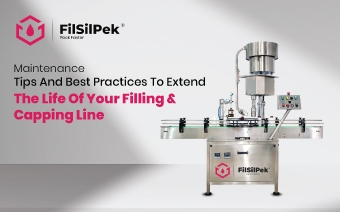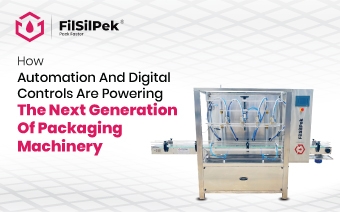How the Automated Packaging System is Changing the Packaging Trends?
The packaging sector is going through a tremendous shift as a result of the quick-paced world we live in today when productivity and efficiency are crucial. Automated packing technologies have been game-changers in the packaging industry, altering procedures and establishing new standards.
This comprehensive blog post examines how automated packing techniques are reshaping the packaging business and altering packaging trends.
What is an Automated Packaging System?
An automated packaging system refers to a sophisticated and technologically advanced set of machinery and equipment designed to automate various tasks involved in the packaging process. These systems are designed to streamline packaging operations, improve efficiency, reduce labor requirements, and enhance productivity.
Automated packaging systems can encompass a range of functions, including filling, sealing, labeling, sorting, palletizing, and even quality control. These systems can handle a wide variety of packaging formats, such as bottles, cartons, bags, boxes, and more. They are commonly used in industries such as food and beverage, pharmaceuticals, cosmetics, electronics, and e-commerce.
Key components of an automated packaging system include:
- Conveyors and Robotics: Automated packaging systems often utilize conveyors and robotics to transport and manipulate products throughout the packaging process. Robotic arms can perform precise and repetitive tasks, such as picking and placing products, while conveyors facilitate the movement of products from one stage to another.
- Filling and Sealing Equipment: These systems may incorporate equipment for filling products into containers, such as liquids, powders, or granules. Sealing equipment ensures proper closure of packages, utilizing methods such as heat sealing, induction sealing, or adhesive sealing.
- Labeling and Coding Systems: Automated packaging systems can include labeling and coding systems to apply labels, barcodes, or date codes onto packages. These systems ensure accurate and consistent labeling, contributing to traceability and compliance requirements.
- Inspection and Quality Control: Some automated packaging systems incorporate vision inspection systems and sensors to detect defects, verify package integrity, or ensure proper labeling. These quality control mechanisms help maintain high packaging standards and reduce the risk of faulty products reaching the market.
- Integration with Software and Control Systems: Automated packaging systems often integrate with software and control systems to manage and monitor the packaging process. These systems provide operators with real-time data, control settings, and analytics for optimization and performance analysis.
Evolution of Automated Packaging System
Technology improvements, shifting consumer preferences, and the desire for greater efficiency in the packaging business have all influenced the development of automated packaging systems. An overview of significant turning points in the development of automated packaging systems is provided below:
Early Mechanical Packaging Machines (Late 19th Century):
In the late 19th century, the first automated packaging machines were developed. These early machines automated processes like filling, sealing, and labeling by using mechanical systems like gears, pulleys, and levers. When compared to manual packaging operations, they offered some rudimentary automation and improved productivity.
Introduction of Electric and Pneumatic Systems (Early to Mid-20th Century):
Automated packaging systems started integrating electric and pneumatic components in the early to mid-20th century. Manual cranks and levers were replaced by electric motors, allowing for faster and more precise operation. Various packing operations, including sealing and labeling, were powered by pneumatic systems that made use of compressed air.
Electronics and PLC Integration (Late 20th Century):
Electronics made major strides in the latter half of the 20th century, and programmable logic controllers (PLCs) were developed. By enabling more complex control and coordination of packaging processes, PLCs revolutionized automated packaging systems. Automation of packaging was made possible by the integration of electronics and PLCs, which led to improvements in accuracy, speed, and flexibility.
Robotics and Vision System Adoption (late 20th century to the present):
An important milestone was reached with the incorporation of robotics and vision technologies in automated packaging systems. Robotic arms have been developed to carry out precise and repetitive activities like choosing, putting, and palletizing products. Quality control, defect detection, and barcode reading were made possible by the integration of vision systems, which included cameras and sensors. These developments increased the scope of jobs that might be automated, increased accuracy, and improved automation capabilities.
Advancements in Software and Control Systems (Present)
Automated packaging systems have grown increasingly intelligent and networked as a result of the development of cutting-edge software and control systems. Real-time data monitoring, analysis, and optimization are made possible by the integration of these systems with software platforms and control systems. They provide seamless supply chain management system integration, data-driven decision-making, and decision-making across several production processes.
Integration of Industry 4.0 and the Internet of Things (IoT) (Present and Future):
The rise of Industry 4.0 and the incorporation of the Internet of Things (IoT) define the current era. Automated packaging systems are being networked to the internet, enabling data sharing with other networked devices as well as remote monitoring and predictive maintenance. Predictive analytics is made possible by this connectedness, which also supports the idea of smart production.
Putting a Present and Future Focus on Sustainability and Eco-Friendly Solutions:
Eco-friendly packaging options and sustainability have received more attention in recent years. Automated packaging systems are developing in order to include features that maximize material consumption, cut waste, and encourage green practices. With these developments, packaging operations will have less of an environmental impact while also providing consumers with sustainable packaging options.
How Automated Packing Systems Are Revolutionizing Packaging Trends?
Enhanced Efficiency and Productivity:
Automated packing systems streamline packaging processes and significantly enhance efficiency and productivity. These systems automate various tasks, such as filling, sealing, labeling, and palletizing, that were previously done manually. By eliminating human error and performing tasks at high speeds, automated packing systems optimize production lines and increase output. This improved efficiency allows businesses to meet growing demand, reduce labor costs, and accelerate order fulfillment.
Improved Accuracy and Quality Control:
One of the critical advantages of automated packing systems is the precision and accuracy they bring to the packaging process. These systems can measure, weigh, and handle products with high precision, ensuring consistent packaging quality and reducing the risk of errors. Additionally, automated systems can incorporate quality control mechanisms, such as vision inspection systems, to detect defects or inconsistencies in packaging materials or products. By improving accuracy and quality control, businesses can deliver products with higher reliability and reduce waste.
Flexibility and Customization:
Automated packing systems offer a level of flexibility and customization that was previously difficult to achieve. These systems can be programmed to handle a wide range of products, sizes, and packaging formats. By adjusting settings, businesses can easily switch between different packaging requirements without significant downtime or reconfiguration. This flexibility allows for rapid adaptation to changing market demands, seasonal variations, or customized packaging options, providing a competitive edge in the industry.
Waste Reduction and Sustainability:
Sustainability has become a major focus for businesses across industries, including packaging. Automated packing systems play a crucial role in waste reduction and sustainable practices. These systems optimize material usage by precisely measuring and dispensing packaging materials, minimizing waste, and reducing environmental impact. Additionally, automated systems can integrate recycling or waste management processes, separating and sorting materials for proper disposal or recycling. By adopting automated packing systems, businesses can contribute to a more sustainable future and meet consumer expectations for eco-friendly practices.
Data Analytics and Traceability:
Automated packing systems generate a wealth of data that can be utilized for analytics and traceability purposes. Through sensors and tracking mechanisms, these systems can capture real-time data on packaging quantities, throughput, machine performance, and more. This data can provide valuable insights into production efficiency, identify bottlenecks, optimize workflows, and enable data-driven decision-making. Furthermore, automated systems can incorporate traceability features, such as barcodes or RFID tags, to track and trace products throughout the supply chain, enhancing transparency and compliance.
Safety and Ergonomics:
Automated packing systems prioritize safety and ergonomics in the packaging process. By automating repetitive and physically demanding tasks, these systems minimize the risk of workplace injuries and improve employee well-being. This shift towards a safer and more ergonomic work environment not only protects the workforce but also reduces downtime due to injuries, ensuring continuous production and business operations.
Conclusion
The packaging industry is changing as a result of automated packing techniques. These solutions are altering packaging trends by facilitating personalization and sustainability while also increasing efficiency and accuracy. Businesses can streamline processes, cut costs, enhance quality control, and adapt to a market that is changing quickly by implementing automated packing systems. Automated packing systems will be essential in defining the future of packaging, fostering innovation, and satisfying the changing needs of both businesses and consumers as technology develops.
Looking to match the steps with current packaging trends to level up your packaging system? – Talk to our experts at +91 9909909285 or write us at [email protected]
Comparing piston vs. gravity filling machines: Which one suits your product best?
Filling machines are a core part of any liquid packaging…..
Maintenance tips and best practices to extend the life of your filling & capping line
A filling and capping line operate at the heart of production…..
How Automation and Digital Controls Are Powering the Next Generation of Packaging Machinery
Packaging machinery has moved far…



